金融数据分析-教学大纲
数据分析技术 教学大纲及授课计划

数据分析技术教学大纲及授课计划一、课程概述本课程旨在向学生介绍数据分析技术的基本概念、原理和方法,培养学生运用数据分析技术解决实际问题的能力。
通过理论讲解与实践操作相结合的方式,学生将研究如何收集、清洗、分析和可视化数据,以及如何运用各种数据分析工具和技术进行数据挖掘和预测分析。
二、教学目标1. 了解数据分析技术的基本概念和应用领域;2. 能够使用常见的数据分析工具和技术进行数据收集、清洗、分析和可视化;3. 掌握数据挖掘和预测分析的基本方法和模型;4. 能够独立运用数据分析技术解决实际问题。
三、教学内容1. 数据分析技术基础知识- 数据分析的定义和流程- 常见的数据分析工具和技术介绍- 数据采集和清洗的方法和技巧2. 数据可视化- 常用的数据可视化工具和技术- 数据可视化的原则和方法- 利用数据可视化解读和传达数据分析结果3. 数据挖掘- 数据挖掘的概念和目标- 常见的数据挖掘算法和模型- 数据挖掘的实际应用案例分析4. 预测分析- 预测分析的基本概念和方法- 常见的预测分析模型和技术- 预测分析在商业决策中的应用案例四、教学方法1. 理论讲授:介绍数据分析技术的理论知识和基本概念;2. 实践操作:引导学生使用具体的数据分析工具和技术进行实际操作;3. 案例分析:通过实际案例的分析,让学生了解数据分析技术的应用场景和实际效果;4. 小组讨论:组织学生进行小组讨论,分享和交流数据分析的经验和方法。
五、教学评估1. 平时成绩:包括课堂表现、实践操作和小组讨论的成绩;2. 期末考试:考察学生对数据分析技术的理论知识和应用能力;3. 课程项目:要求学生完成一个实际的数据分析项目,评估其数据分析能力和解决问题的能力。
六、参考教材1. 《Python数据分析与挖掘实战》2. 《R语言数据分析与挖掘实战》3. 《数据可视化实战:Tableau数据分析与应用》七、参考资源以上为《数据分析技术教学大纲及授课计划》的内容,供参考。
数据分析教学大纲解析

数据分析教学大纲解析我要介绍的是数据分析教学大纲的总体目标。
通过本课程的学习,学生将能够掌握数据分析的基本概念、方法和技巧,培养数据分析和解决实际问题的能力。
同时,学生还将学会如何运用数据分析工具和软件,提高数据处理和分析的效率。
第一章是数据分析概述。
本章将介绍数据分析的定义、意义和应用领域。
学生将了解数据分析的发展历程,掌握数据分析的基本流程和方法。
第二章是数据收集与整理。
本章将介绍数据收集的方法和技巧,以及数据整理的基本方法。
学生将学会如何从不同来源获取数据,对数据进行清洗、转换和整合。
第三章是数据分析方法。
本章将介绍描述性统计分析、推断性统计分析以及预测分析等方法。
学生将掌握各类分析方法的原理、应用场景和计算方法。
第四章是数据分析工具与软件。
本章将介绍常见的数据分析工具和软件,如Excel、SPSS、Python等。
学生将通过实践操作,学会如何运用这些工具进行数据分析。
第五章是数据分析案例研究。
本章将通过具体的案例分析,使学生将所学知识应用于实际问题。
案例涉及多个领域,如金融、市场营销、生物学等。
第六章是数据分析实践项目。
本章将要求学生完成一个数据分析实践项目,从数据收集、整理、分析到结果呈现,全面锻炼学生的数据分析能力。
教学大纲还包括了考核与评价部分。
学生将通过课堂参与、作业、实践项目和期末考试等方式展示自己的学习成果。
考核内容涵盖了数据分析的理论知识、实践技能和应用能力。
数据分析教学大纲旨在为学生提供一个全面、系统的数据分析学习体系。
通过本课程的学习,学生将具备扎实的数据分析基础,能够运用所学知识解决实际问题。
希望这篇解析能帮助您更好地了解数据分析教学大纲,为您的学习之旅奠定坚实基础。
在数据的世界里,我是一位探索者,带领学生们穿越信息的海洋,解锁知识的宝藏。
今天,我要分享的是我对数据分析教学大纲的深刻理解,它不仅是一份课程指南,更是一份通往智慧之门的地图。
当我初次接触到数据分析的教学大纲,我看到了一个精心设计的框架,它将抽象的数据转化为可感知的见解。
数据分析教学大纲
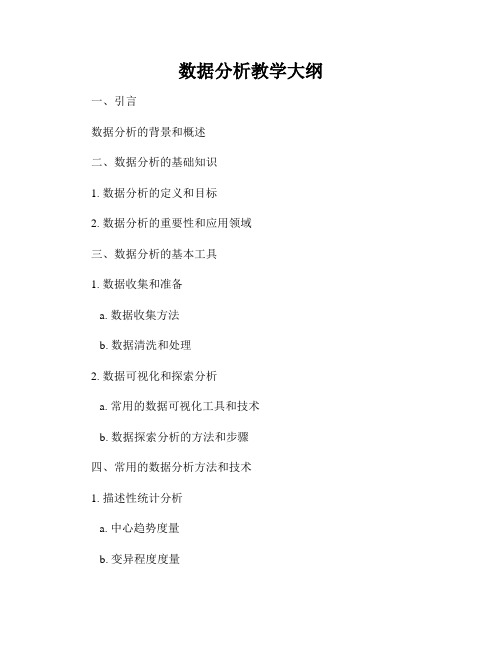
数据分析教学大纲一、引言
数据分析的背景和概述
二、数据分析的基础知识
1. 数据分析的定义和目标
2. 数据分析的重要性和应用领域
三、数据分析的基本工具
1. 数据收集和准备
a. 数据收集方法
b. 数据清洗和处理
2. 数据可视化和探索分析
a. 常用的数据可视化工具和技术
b. 数据探索分析的方法和步骤
四、常用的数据分析方法和技术
1. 描述性统计分析
a. 中心趋势度量
b. 变异程度度量
2. 统计推断和假设检验
a. 参数估计和假设检验的基本原理
b. 常用的统计推断方法
3. 相关分析
a. 相关分析的概念和方法
b. 相关系数的计算和解释
4. 预测分析
a. 时间序列预测分析
b. 回归分析和机器学习方法
五、数据分析实践案例
1. 金融领域的数据分析实践
a. 股票市场分析
b. 风险管理和投资组合优化
2. 市场营销领域的数据分析实践
a. 用户行为分析
b. 市场细分和定位分析
六、数据分析教学的案例设计和评估
1. 教学案例的设计原则和步骤
2. 教学案例的评估方法和指标
七、数据分析的挑战和未来发展
1. 数据隐私和安全问题
2. 大数据和人工智能对数据分析的影响
结语
总结数据分析教学大纲的重点内容和意义,为学习者提供一个清晰的学习路线和方向。
参考文献
列举相关的参考文献和学术资源,供学习者进一步深入了解数据分析的相关领域和知识。
金融数据分析教学大纲

金融数据分析教学大纲金融数据分析教学大纲随着金融行业的快速发展和数字化转型,金融数据分析的重要性日益凸显。
金融数据分析是一门综合性学科,涉及统计学、计量经济学、金融学等多个领域的知识和技能。
为了培养具备金融数据分析能力的人才,制定一份科学合理的教学大纲至关重要。
一、引言金融数据分析作为一门学科,旨在通过对金融数据的收集、整理、分析和解释,为金融决策提供可靠的依据。
本教学大纲旨在培养学生的数据分析思维和技能,使其能够熟练运用各种统计工具和软件,深入理解金融市场的运行规律,为金融机构和企业提供准确的数据分析支持。
二、基础知识1. 金融数据分析的概念和意义:介绍金融数据分析的基本概念,探讨其在金融领域中的重要性和应用价值。
2. 统计学基础:回顾统计学的基本概念和方法,包括概率论、随机变量、概率分布等,为后续的数据分析方法打下基础。
3. 金融市场基础知识:介绍金融市场的基本特征和运行机制,包括证券市场、货币市场、外汇市场等,为后续的数据分析提供背景知识。
三、数据收集与整理1. 数据源和获取:介绍金融数据的常见来源,如金融机构、政府部门、第三方数据提供商等,以及如何获取和整理这些数据。
2. 数据清洗与预处理:讲解数据清洗的概念和方法,包括缺失值处理、异常值处理、数据转换等,以确保数据的质量和可用性。
3. 数据格式和结构:介绍金融数据的常见格式和结构,如时间序列数据、面板数据等,以及如何进行数据格式转换和重构。
四、数据分析方法1. 描述性统计分析:介绍描述性统计分析的基本概念和方法,包括中心趋势度量、离散程度度量、相关性分析等,以了解数据的基本特征。
2. 统计推断与假设检验:讲解统计推断的基本原理和方法,包括参数估计、假设检验、置信区间等,以从样本数据中推断总体的特征。
3. 时间序列分析:介绍时间序列分析的基本概念和方法,包括平稳性检验、自相关性分析、滑动平均等,以研究时间序列数据的内在规律。
4. 回归分析:讲解回归分析的基本原理和方法,包括线性回归、多元回归、时间序列回归等,以探究变量之间的关系和影响。
金融数据分析课程设计
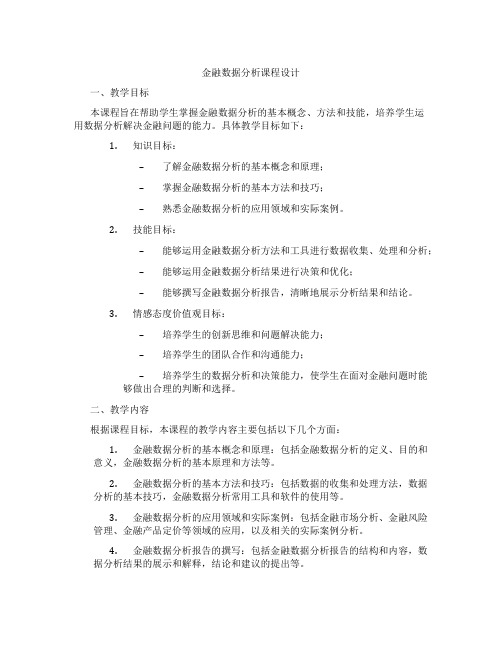
金融数据分析课程设计一、教学目标本课程旨在帮助学生掌握金融数据分析的基本概念、方法和技能,培养学生运用数据分析解决金融问题的能力。
具体教学目标如下:1.知识目标:–了解金融数据分析的基本概念和原理;–掌握金融数据分析的基本方法和技巧;–熟悉金融数据分析的应用领域和实际案例。
2.技能目标:–能够运用金融数据分析方法和工具进行数据收集、处理和分析;–能够运用金融数据分析结果进行决策和优化;–能够撰写金融数据分析报告,清晰地展示分析结果和结论。
3.情感态度价值观目标:–培养学生的创新思维和问题解决能力;–培养学生的团队合作和沟通能力;–培养学生的数据分析和决策能力,使学生在面对金融问题时能够做出合理的判断和选择。
二、教学内容根据课程目标,本课程的教学内容主要包括以下几个方面:1.金融数据分析的基本概念和原理:包括金融数据分析的定义、目的和意义,金融数据分析的基本原理和方法等。
2.金融数据分析的基本方法和技巧:包括数据的收集和处理方法,数据分析的基本技巧,金融数据分析常用工具和软件的使用等。
3.金融数据分析的应用领域和实际案例:包括金融市场分析、金融风险管理、金融产品定价等领域的应用,以及相关的实际案例分析。
4.金融数据分析报告的撰写:包括金融数据分析报告的结构和内容,数据分析结果的展示和解释,结论和建议的提出等。
三、教学方法为了实现课程目标,本课程将采用多种教学方法,包括:1.讲授法:通过教师的讲解和演示,向学生传授金融数据分析的基本概念、原理和方法。
2.讨论法:通过小组讨论和全班讨论,培养学生的思考和分析能力,提高学生的参与度和积极性。
3.案例分析法:通过分析实际案例,使学生更好地理解和应用金融数据分析的方法和技巧。
4.实验法:通过实验和练习,巩固学生对金融数据分析方法和工具的掌握,提高学生的实际操作能力。
四、教学资源为了支持教学内容和教学方法的实施,本课程将利用以下教学资源:1.教材:选择适合本课程的教材,提供学生系统性的学习材料。
课程教学大纲_金融统计分析教学大纲
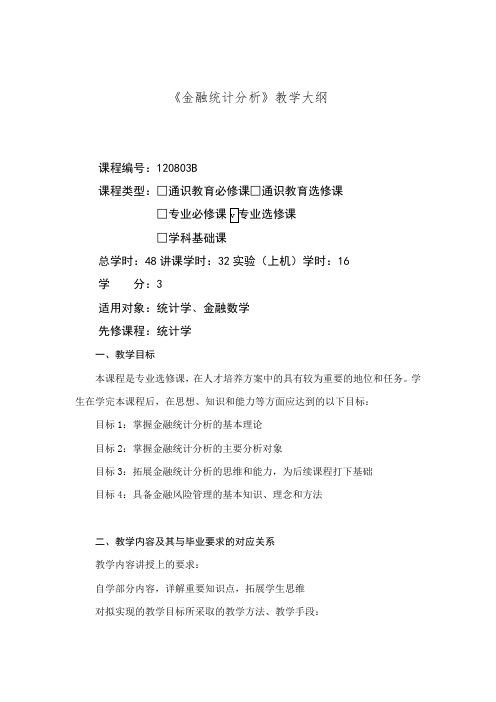
《金融统计分析》教学大纲课程编号:120803B课程类型:□通识教育必修课□通识教育选修课□专业必修课□学科基础课总学时:48讲课学时:32实验(上机)学时:16学分:3适用对象:统计学、金融数学先修课程:统计学一、教学目标本课程是专业选修课,在人才培养方案中的具有较为重要的地位和任务。
学生在学完本课程后,在思想、知识和能力等方面应达到的以下目标:目标1:掌握金融统计分析的基本理论目标2:掌握金融统计分析的主要分析对象目标3:拓展金融统计分析的思维和能力,为后续课程打下基础目标4:具备金融风险管理的基本知识、理念和方法二、教学内容及其与毕业要求的对应关系教学内容讲授上的要求:自学部分内容,详解重要知识点,拓展学生思维对拟实现的教学目标所采取的教学方法、教学手段:传统与现代相结合的教学方法和教学手段对实践教学环节的要求:要求理论联系实际对课后作业以及学生自学的要求:每次课都有相应的作业和自学内容该课程从哪些方面促进了毕业要求的实现:本课程进一步丰富了学生的金融分析理论与实际应用的知识与思维能力。
三、各教学环节学时分配以表格方式表现各章节的学时分配,表格如下:教学课时分配四、教学内容第一章Introduction教学重点、难点:Forward contracts, Future contracts, Options, Hedgers, Speculations, Arbitrageurs课程的考核要求:掌握和运用Forward contracts, Future contracts, Options, Hedgers, Speculations, Arbitrageurs等基本术语复习思考题:见教材1第二章Mechanics of future markets教学重点、难点:Daily settlement and margins课程的考核要求:理解和运用Mechanics of future markets复习思考题:见教材1第三章Hedging strategiesusing futures教学重点、难点:Basic principles and cross hedging课程的考核要求:理解和运用Hedging strategiesusing futures复习思考题:见教材1第四章Interest rates教学重点、难点:Bond pricing, Forward rates, Duration课程的考核要求:理解和掌握Bond pricing, Forward rates, Duration 概念和计算复习思考题:见教材1第五章Determination of forward and future prices教学重点、难点:Shorting selling, Forward price for an investment asset, Valuing forward contracts课程的考核要求:掌握和应用Shorting selling, Forward price for an investment asset, Valuing forward contracts复习思考题:见教材1第六章Interest rate futures教学重点、难点:Duration-based hedging strategies using futures 课程的考核要求:了解Interest rate futures的基本概念和应用复习思考题:见教材1第七章Swaps教学重点、难点:Mechanics of interest rate swaps课程的考核要求:理解互换的理论,掌握和应用Mechanics of interest rate swaps复习思考题:见教材1第八章Mechanics of options markets教学重点、难点:option positions, margins课程的考核要求:掌握和应用Mechanics of options markets复习思考题:见教材1第九章Properties of stock options教学重点、难点:put-call parity, effect of dividends课程的考核要求:理解和应用Properties of stock options复习思考题:见教材1第十章Trading strategies involving options教学重点、难点:strategies involving a single option and a stock 课程的考核要求:理解和应用Trading strategies involving options 复习思考题:见教材1Handbook第一章Introduction教学重点、难点:Debt securities, Equity securities, Investment fund shares or units课程的考核要求:了解本书的基本框架,理解和运用Debt securities, Equity securities, Investment fund shares or units复习思考题:见教材2Handbook第二章 Main features of securities教学重点、难点:Debt securities, Equity securities课程的考核要求:掌握和应用Debt securities, Equity securities的主要特征复习思考题:见教材2Handbook第三章 Financial instruments classified as securities教学重点、难点:Financial instruments课程的考核要求:正确理解和运用Financial instruments复习思考题:见教材2Handbook第四章Institutional units and sections教学重点、难点:Definition of an institutional unit and residence 课程的考核要求:正确理解和运用Institutional units and sections 复习思考题:见教材2Handbook第五章Positions, flows and accounting rules教学重点、难点:Quadruple-entry accounting, Gross and Net transaction 课程的考核要求:理解和运用Positions, flows and accounting rules 复习思考题:见教材2Handbook第六章Specific operations related to securities教学重点、难点:Securitization, Debt-for-Equity swaps课程的考核要求:理解和掌握Securitization, Debt-for-Equity swaps, stock splits and reverse splits, share buybacks and so on.复习思考题:见教材2Handbook第七章Classification of securities教学重点、难点:Classification of securities课程的考核要求:理解和应用根据不同标志进行securities分组分类。
《金融市场数据分析与数据挖掘》教学大纲
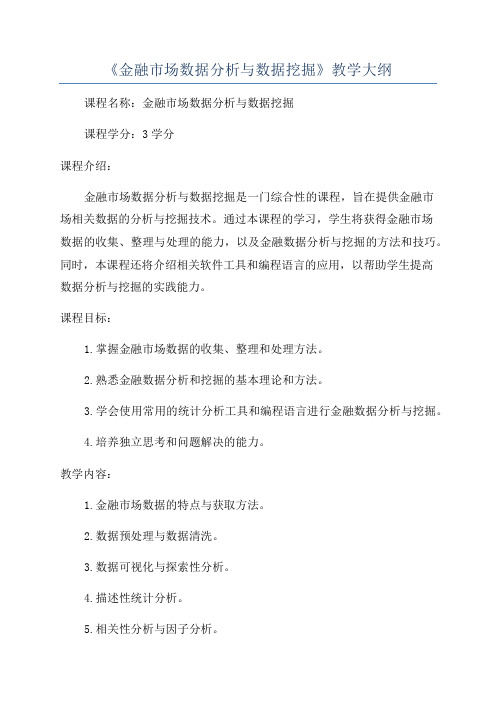
《金融市场数据分析与数据挖掘》教学大纲课程名称:金融市场数据分析与数据挖掘课程学分:3学分课程介绍:金融市场数据分析与数据挖掘是一门综合性的课程,旨在提供金融市场相关数据的分析与挖掘技术。
通过本课程的学习,学生将获得金融市场数据的收集、整理与处理的能力,以及金融数据分析与挖掘的方法和技巧。
同时,本课程还将介绍相关软件工具和编程语言的应用,以帮助学生提高数据分析与挖掘的实践能力。
课程目标:1.掌握金融市场数据的收集、整理和处理方法。
2.熟悉金融数据分析和挖掘的基本理论和方法。
3.学会使用常用的统计分析工具和编程语言进行金融数据分析与挖掘。
4.培养独立思考和问题解决的能力。
教学内容:1.金融市场数据的特点与获取方法。
2.数据预处理与数据清洗。
3.数据可视化与探索性分析。
4.描述性统计分析。
5.相关性分析与因子分析。
6.时间序列分析与预测。
7.机器学习算法在金融数据挖掘中的应用。
8.金融风险分析与模型构建。
教学方法:1.理论讲授:通过教师讲解金融数据分析和挖掘的基本理论和方法,帮助学生建立相应的基础知识。
2.实例分析:通过案例分析,引导学生运用所学知识分析实际金融市场数据。
3.讨论与交流:组织学生进行讨论和交流,促进学生之间的互动和思维碰撞。
4.实践操作:通过实践操作,帮助学生熟悉常用的统计分析工具和编程语言,提高数据分析与挖掘的实践能力。
评估方式:1.平时成绩:考勤、课堂表现、课堂讨论等。
2.作业成绩:按时完成平时作业并准确无误。
3.期中考试:对课程前半部分内容进行考察。
4.期末考试:对课程全部内容进行考察。
5.课程设计:根据实际金融市场数据进行分析与挖掘,并撰写实验报告。
参考教材:1.李梅,《大数据金融学》,机械工业出版社。
2. Tan, et al., "Introduction to Data Mining", Pearson Education, 2024.。
参考工具:1. Python编程语言及相关库(numpy、pandas、matplotlib、scikit-learn等)。
经济数据建模与分析-大纲
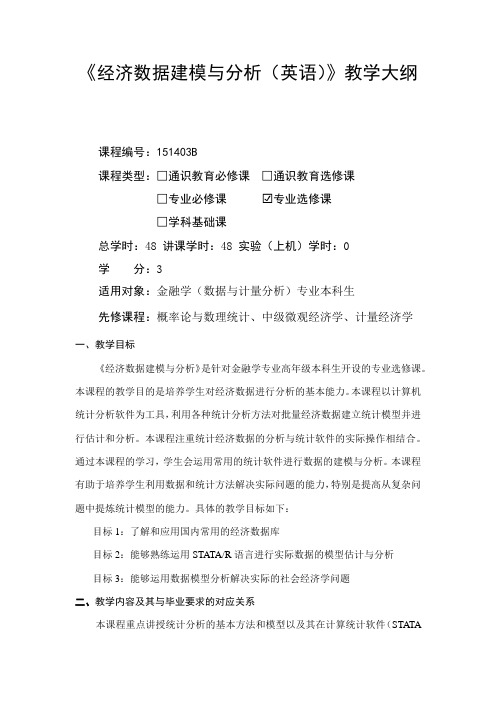
福建省晋江市平山中学2017-2018 学年高二下学期期末考试文综试题一、选择题:本题共35小题,每小题4分,共140分。
在每小题给出第四个选项中,只有一项是符合题目要求的。
读图,回答1-2小题。
1.若甲、丙两点间的图上距离为2.2cm,则该图的比例尺约为()A. 1∶1000B. 1∶10000万C. 1∶500万D. 1∶5000万2.图中四地()A. 乙、丁两地地方时相同B. 甲、丙两地昼夜长短相同C. 乙、丁两地正午太阳高度相同D. 甲、丙两地日出、日落时间相同净光合作用量=光合作用量-呼吸作用量。
下图是某地绿色植物的光合作用量、呼吸作用量与气温关系统计曲线。
完成3-4 题。
3.绿色植物净光合作用量会受太阳辐射、气温、降水量、土壤养分等因素的影响,这反映出自然地理环境具有A.整体性B.差异性C.可塑性D.临界性4.气温25℃以上,该地绿色植物光合作用量不再随气温升高而增加,其主要制约因素最有可能是A.光照B.水分C.热量D.C02图为“南美洲自然带分布示意图”。
读图回答5-6题。
5.图中各数字对应的自然带名称,正确的是A.②热带草原带B.③温带落叶阔叶林带 C.④亚热带常绿硬叶林带D.⑥热带荒漠带6.影响⑥自然带出现南、北狭长分布的主要原因是 A.受南美洲西部山脉阻挡,呈南、北狭长分布 B.受海陆分布的影响,向南伸展到30°S附近C.受所跨纬度影响,向西直通海岸 D.受西风带的影响,向北延伸范围更广2016年9月2日0时37分,在新西兰北岛附近海域发生6.9级地震,震源深度30千米。
读图“震中位置示意图”。
据此完成7-8题。
7.新西兰多地震的原因主要是A. 印度洋板块与太平洋板块挤压碰撞B. 亚欧板块与印度洋板块挤压碰撞C. 印度洋板块与南极洲板块挤压碰撞D. 南极洲板块与太平洋板块挤压碰撞8.社会经济基础雄厚、政治稳定的地区,能够“缩小”灾情,主要是因为①有能力建设健全的防灾系统②灾害发生时能迅速救援③能够把自然灾害消灭在萌芽状态④能得到国际社会的援助A.①②B.③④C.①③D.②④水进型三角洲是三角洲体系中的一个重要类型,是指当水盆(湖和海)水面不断上升,河流所携沉积物在河湖(海)交汇地带沉积下来,并逐渐往陆地方向退积,在其有效沉积率小于水面上升速度的条件下,在原三角洲沿岸平原之上所形成的一套水下沉积的、粒度规律的沉积体。
- 1、下载文档前请自行甄别文档内容的完整性,平台不提供额外的编辑、内容补充、找答案等附加服务。
- 2、"仅部分预览"的文档,不可在线预览部分如存在完整性等问题,可反馈申请退款(可完整预览的文档不适用该条件!)。
- 3、如文档侵犯您的权益,请联系客服反馈,我们会尽快为您处理(人工客服工作时间:9:00-18:30)。
《金融数据分析》教学大纲The Course Outline of Financial DataAnalysis课程编号:151222B课程类型:专业选修课总学时:32 讲课学时:16 实验(上机)学时:16学分:2适用对象:金融学(金融经济实验班)先修课程:计量经济学、微观经济学、宏观经济学、概率论与数理统计、线性代数、微积分Course Code:Course Type: Discipline Elective CoursePeriods: 32 Lecture: 16 Experiment (Computer): 16Credits: 2Applicable Subjects: Finance(Finance and Economics Experiment Class)Prerequisite Courses: Econometrics, Microeconomics, Macroeconomics, Probability and Statistics, Linear Algebra, Calculus一、课程简介本课程是面向金融学、经济学和管理学相关专业的高年级本科生开设的学科专业选修课程,主要介绍应用于金融数据分析中的经典计量方法,并注重培养学生的实际操作能力。
Financial data analysis is an elective course for advanced undergraduate students majored in finance, economics and management. In this course, we not only introduce basic econometric methods applied to financial data, but also train students’ practical skills of handling financial data.二、教学目标本课程包括以下教学目标:(1)使学生能运用所学的金融计量理论分析和解释实际金融数据;(2)着重为对金融理论进行实证分析提供所需的估计和检验方法;(3)使学生运用计算机软件(以R语言为主)进行金融数据研究。
This course has the following teaching goals: (1) equipping students with econometric tools to analyze and explain financial data, (2) focusing on the estimation and inferential methods used in empirical analysis of finance theory, and (3) enabling students to implement these techniques using computer software, primarily R programming language.二、教学基本要求这门课程主要讲授如何利用海量金融数据对金融理论进行实证分析,以及在处理实际金融数据时所需的计量方法和计算机技术。
因此,在教学内容的讲授过程中,授课老师需要做到理论与实践并重。
理论学习包括金融数据概述,平稳时间序列分析,非平稳性时间序列分析,波动率分析,股票回报率预测,等。
在时间允许的情况下,我们还将介绍,多维向量自回归模型, 以及协整和误差纠正模型。
对于上述所有的模型的分析,本课程提供相应的实际金融数据,以及完整的R程序与讲解说明文件。
本课程教学方法将以课堂讲授为主。
由于课程内容难度相对较大,我们鼓励学生课前预习,课上积极参与讨论,并课后复习和独立完成作业。
R语言的学习以课堂展示和学生上机实际操作的方式完成。
课程考核由考勤、作业、研究项目、和期末考试组成。
考核成绩为百分制,各项分数分配见表(一)。
表(一):分数分配方式出勤10%作业30%期末闭卷考试30%研究项目30%The main content of this course is to explain how to handle a huge amount of financial data and to conduct empirical analysis based on financial theories. Thus, this course will weight equally on both learning econometric theories and real applications. Theoretical study will mainly cover such topics as introduction to financial data, stationary time series analysis, non-stationary time series analysis, volatility analysis, and stock return prediction. If time permits, we will also learn vector autoregressive models (V AR) and cointegration and error correction models. All the models are accompanied with real-data examples with complete R programs and tutorials.The basic teaching strategy of this course mainly involves in-class lectures. Due to the difficulty of the course, we encourage students to browse the assigned reading materials before class, to proactively participate discussions in class, and to peruse lecture notes and independently complete homework after class. Students will learn R through in-class instructions and practice.The methods of the course evaluation include attendance, homework, project work, and final exam. The grade distribution of each component within one hundred percentage points is presented in Table 1Table 1: The grade distributionAttendance 10%Assignments 30%Final Exam (closed) 30%Project Work 30%三、各教学环节学时分配教学课时分配(Class Schedule)四、教学内容第一章金融市场数据的特征第一节数据:金融数据的实证特征对金融建模很重要第二节概括性的统计量第三节分位数相关的分析1.在险价值2.期望损失3.密度预测第四节实证分析1.有效市场假说2.方差比检验教学重点、难点:在险价值和期望损失的计算课程的考核要求:计算在险价值和期望损失,用计量软件检验有效市场假说第二章平稳时间序列第一节ARMA过程1.数据2.模型性质第二节估计,检验和模型选择1.MLE估计方法2.统计量3.ARMA模型选择第三节预测1.预测过程2.预测评估第四节实证分析教学重点、难点:ARMA过程模型性质和预测课程的考核要求:分析ARMA过程模型性质和预测,用计量软件预测ARMA过程第三章非平稳时间序列第一节单位根过程和确定性时间序列1.数据2.单位根过程的模型性质3.含有确定性时间序列模型的性质第二节估计,检验和模型选择1.MLE估计方法2.单位根检验3.滞后阶数的选择第三节预测1.预测过程2.预测评估第四节实证分析1.泡沫检验2.泡沫起始时间的估计教学重点、难点:单位根检验和泡沫检验课程的考核要求:分析单位根过程的模型性质,用计量软件进行单位根检验第四章波动率第一节资产价格过程的波动聚类第二节自回归条件异方差模型(ARCH)1.模型性质2.估计方法3.模型选择第三节广义自回归条件异方差模型(GARCH)1.模型性质2.估计方法3.模型选择第四节实证分析教学重点、难点:ARCH和GARCH模型的估计课程的考核要求:用ARCH和GARCH模型来分析现实金融数据的波动性第五章股票回报率预测第一节股票回报率预测(i)3.预测回归4.长期预测回归第二节股票回报率预测(ii)5.资本资产定价模型6.多因子模型第三节实证分析教学重点、难点:预测回归和多因子模型课程的考核要求:用计量软件检验股票收益的可预测性第六章多元时间序列建模第一节向量自回归过程1.数据2.向量自回归过程的模型性质3.估计,检验和模型选择4.脉冲响应函数分析5.预测方差分解第二节伪回归和协整模型1.伪回归模型2.协整模型第三节向量误差修正模型1.模型性质2.模型估计教学重点、难点:向量自回归过程的模型性质和协整关系检验课程的考核要求:分析向量自回归过程的模型性质,用计量软件进行协整关系检验Chapter 1 The Characteristics of Financial Market DataSection 1 The Data: The empirical characteristics of financial data are important for building financial models.Section 2 Summary StatisticsSection 3 Percentiles related statistics1.Value-at-Risk2.Expected Shortfall3.Density Forecasting EstimationSection 4 Empirical Analysis1.Effcient Market Hypothesis2.Variance Ratio TestsKey and Difficult Points: calculation of Value-at-Risk and Expected Shortfall Evaluation Requirements: calculation of Value-at-Risk and Expected Shortfall, and testing the Effcient Market Hypothesis by econometric softwareChapter 2 Stationary Time SeriesSection 1 ARMA processes1.Data2.PropertiesSection 2 Estimation, Inference and Model Selection1.Estimation by MLE2.Test Statistics3.ARMA Model SelectionSection 3 Forecasting1.Forecasting Procedure2.Forecasting EvaluationSection 4 Empirical AnalysisKey and Difficult Points: the properties of ARMA process and forecasting using ARMA modelEvaluation Requirements: the properties of ARMA process, and forecasting using ARMA model by econometric softwareChapter 3 Nonstationary Time SeriesSection 1 Unit Root and Deterministic Trends1.Data2.Properties of Unit Root Model3.Properties of Model with Deterministic TrendsSection 2 Estimation, Inference and Model Selection1.Estimation by MLE2.Unit Root Testg-length Model SelectionSection 3 Forecasting1.Forecasting Procedure2.Forecasting EvaluationSection 4 Empirical Analysis1.Bubble Test2.Data Stamping of BubblesKey and Difficult Points: Unit root test and Data Stamping of BubblesEvaluation Requirements: Properties of Unit Root Model, and test unit root by econometric softwareChapter 4 VolatilitySection 1 V olatility Clustering of Asset Price ProcessesSection 2 Autoregressive Conditional Heteroscedasticity Model(ARCH)1.Properties2.Estimation3.Model SelectionSection 3 Generalized Autoregressive Conditional Heteroscedasticity Model(GARCH)1.Properties2.Estimation3.Model SelectionSection 4 Empirical AnalysisKey and Difficult Points: estimation of ARCH and GARCH modelsEvaluation Requirements:apply ARCH and GARCH models to real data in financeChapter 5 Stock Return PredictabilitySection 1 Stock Return Predictability (i)1.Predictive Regression2.Long-horizon Predictive RegressionSection 2 Stock Return Predictability (ii)1.Capital Asset Pricing Model (CAPM)2.Multifactor ModelsSection 3 Empirical AnalysisKey and Difficult Points: Predictive Regression and Multifactor ModelsEvaluation Requirements: Test stock return predictability by PredictiveRegression using econometric softwareChapter 6 Multivariate Time SeriesSection 1 Vector Autoregressive Models1.Data2.Properties of Vector Autoregressive Models3.Estimation, Inference and Model Selection4.Impulse Response Analysis5.Forecast error variance decompositionsSection 2 Spurious Regression and Cointegration1.Spurious Regression2.CointegrationSection 3 Vector Error Correction Model1.Properties2.EstimationKey and Difficult Points: Vector Autoregressive Models and CointegrationEvaluation Requirements: Properties of Vector Autoregressive Models and Cointegration test by econometric software五、其它授课老师应根据学生的能力适当调节课程进度和内容Instructor should adjust the course schedule and content according to the capability of students.六、主要参考书[1] Walter Enders. Applied Econometric Time Series, 4th edition. Wiley. 2014[2] Ruey S. Tsay.An Introduction to Analysis of Financial Data with R. Wiley.2012执笔人:田峥教研室主任:系教学主任审核签名:11。
